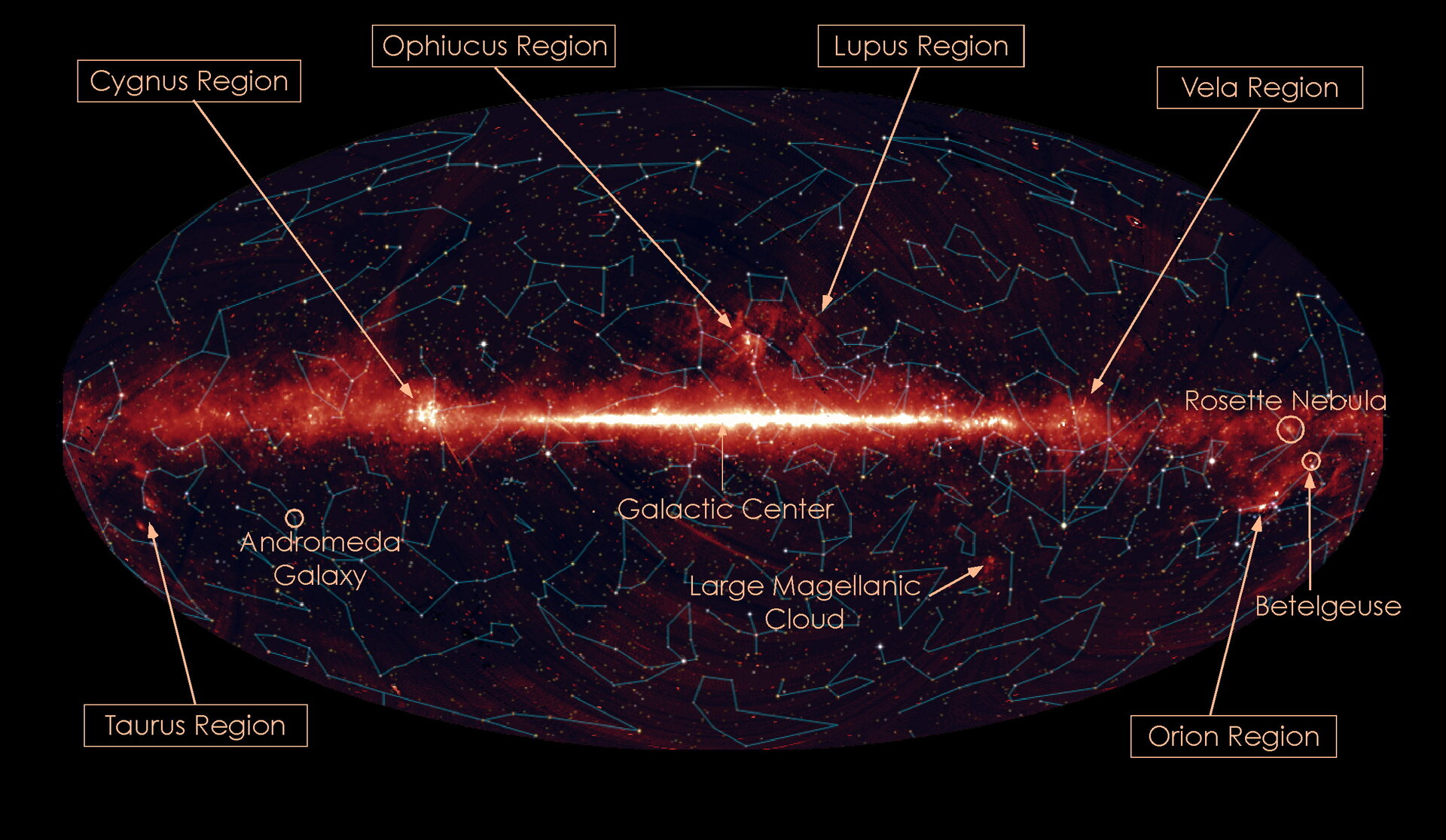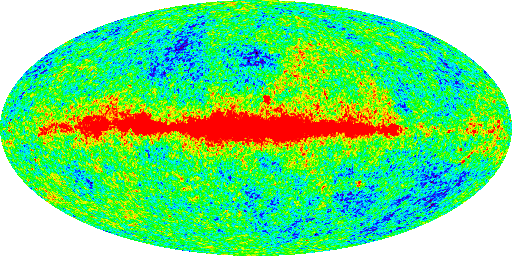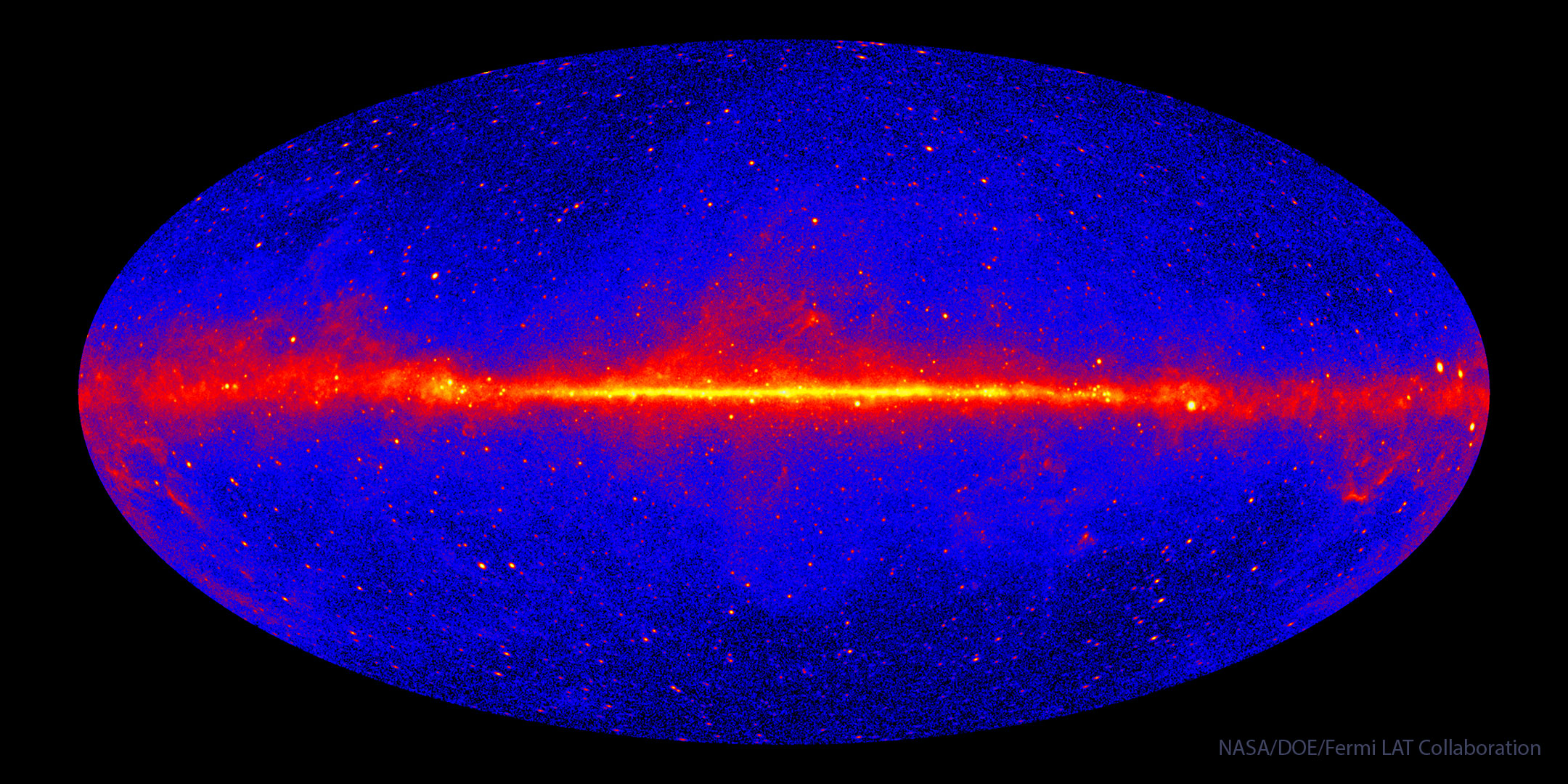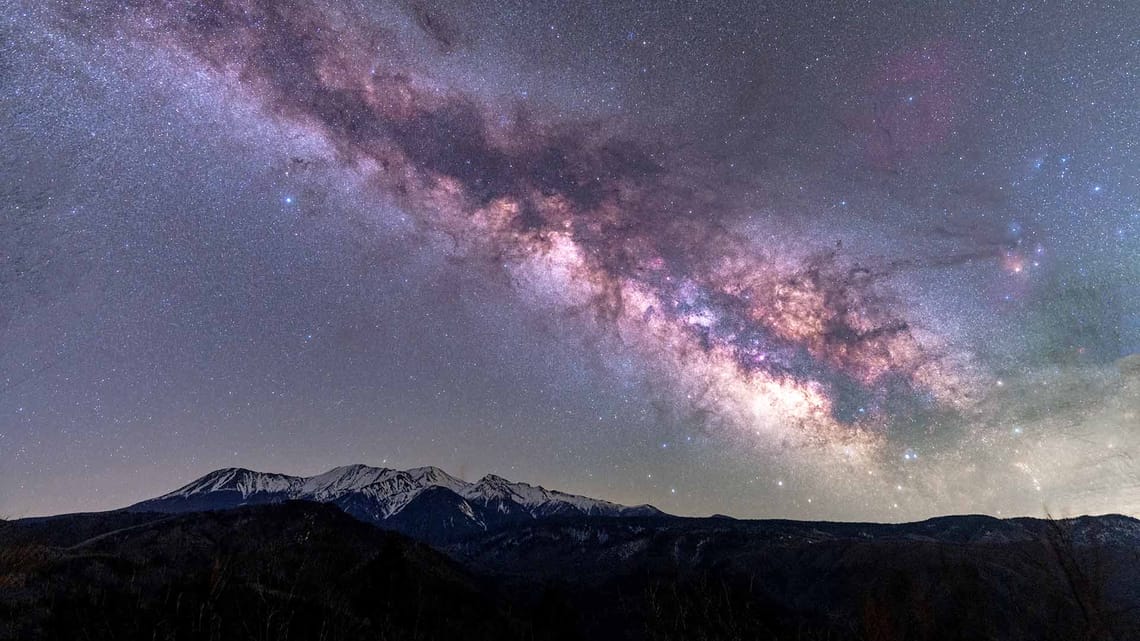Page 1 of 1
APOD: Fermi's 12-year All-Sky Map... (2024 Aug 21)
Posted: Wed Aug 21, 2024 4:06 am
by APOD Robot
 Fermi's 12-year All-Sky Gamma-ray Map
Explanation:
Fermi's 12-year All-Sky Gamma-ray Map
Explanation: Forget
X-ray vision â imagine what you could see with
gamma-ray vision! The
featured all-sky map shows what the universe looks like to NASA's
Fermi Gamma-ray Space Telescope. Fermi sees light with energies about a billion times what the
human eye can see, and
the map combines 12 years of Fermi observations. The colors represent the brightness of the
gamma-ray sources, with brighter sources appearing lighter in color. The prominent stripe across the middle is the central plane of our
Milky Way galaxy. Most of the red and yellow dots scattered above and below the Milky Wayâs plane are very
distant galaxies, while most of those within
the plane are nearby
pulsars. The
blue background that fills the image is the
diffuse glow of gamma-rays from distant sources that are too dim to be detected individually. Some gamma-ray sources
remain unidentified and topics of research â currently
no one knows what they are.
Re: APOD: Fermi's 12-year All-Sky Map... (2024 Aug 21)
Posted: Wed Aug 21, 2024 4:35 am
by Ann
APOD Robot wrote:
Most of the red and yellow dots scattered above and below the Milky Way’s plane are very distant galaxies, while most of those within the plane are nearby pulsars.
Given the fact that the Milky Way is so bright in gamma rays, where is Andromeda? It can hardly be less bright in gamma rays than the Milky Way, can it?
Let's compare the all-sky gamma ray map with an all-sky infrared map and see if Andromeda turns up:
Andromeda can't be seen in either gamma rays or in infrared light at this resolution! Andromeda is a quiet big old galaxy, isn't it?
It appears to be faintly visible in X-rays, however:
A new X-ray map of the entire sky reveals all kinds of energetic objects
and phenomena in the Milky Way and beyond.
Credit: Jeremy Sanders, Hermann Brunner and the ESASS TEAM/MPE,
Eugene Churazov, Marat Gilfanov (on behalf of IKI)
I think it is Andromeda that is showing up faintly to the lower right of the Cygnus Superbubble.
Oh, and by the way: Yes, you can see the Large Magellanic Cloud in the all-sky gamma ray map. I would guess that the brightest red dot in the position of the LMC in the gamma ray map is the Tarantula Nebula!
Ann
Re: APOD: Fermi's 12-year All-Sky Map... (2024 Aug 21)
Posted: Wed Aug 21, 2024 5:25 am
by shaileshs
Very interesting today's APOD. Quick 2 questions -
1) What's the size of the sky captured ? Is it full (whatever is "visible" to space telescope) ? e.g 13 billion light years across 360deg ?
2) Since the data is of 12 years, I'd imagine some prominent gamma ray bursts might have got recorded (whether only for a split second or more frequent, whether from within our galaxy or from anywhere in whole sky map).. How do we know and differentiate those from ones which are continuous and ongoing gamma ray sources ?
Re: APOD: Fermi's 12-year All-Sky Map... (2024 Aug 21)
Posted: Wed Aug 21, 2024 8:56 am
by Ann
shaileshs wrote: ↑Wed Aug 21, 2024 5:25 am
Very interesting today's APOD. Quick 2 questions -
1) What's the size of the sky captured ? Is it full (whatever is "visible" to space telescope) ? e.g 13 billion light years across 360deg ?
2) Since the data is of 12 years, I'd imagine some prominent gamma ray bursts might have got recorded (whether only for a split second or more frequent, whether from within our galaxy or from anywhere in whole sky map).. How do we know and differentiate those from ones which are continuous and ongoing gamma ray sources ?
I was going to try to answer, but I realized that I didn't have any good answers.
I believe that, in principle, the gamma ray sky could encompass the entire sky, almost but not quite all the way down to the Big Bang. At least if we talk about the sky near the Milky Way and then extend the depth of it all the way to the emission of the cosmic microwave background, emitted some 400 million years after the Big Bang.
Of course, any gamma rays that were emitted some 13.8 billion years ago will have had their wavelengths stretched so that they are no longer gamma rays.
As for whether or not the gamma ray detectors that produced the images that went into this APOD also detected gamma ray bursts, I'd say that unless they operated all over the sky 24/7 365 days a year, chances are that the gamma ray bursts have been missed.
But I don't know. Ask Chris!
Ann
Re: APOD: Fermi's 12-year All-Sky Map... (2024 Aug 21)
Posted: Wed Aug 21, 2024 1:10 pm
by dduggan47
If anyone wonders if folks at NASA have a sense of humor, or if you just need a smile to start your day, be sure to click on the "no one knows" link.
Re: APOD: Fermi's 12-year All-Sky Map... (2024 Aug 21)
Posted: Wed Aug 21, 2024 3:38 pm
by Roy
I'm having trouble understanding cosmic rays. It is defined as a photon. A photon is defined as a particle with no mass. It travels at c. We know that E = mass x (velocity)squared. So how does the photon gain enormous energy, represented as a very high frequency, if it can not have mass, or go faster?
It is detected when it strikes an electron, breaking it loose from it's atom and sending it off in one direction while continuing on at a lower frequency in another. As i understand it this is called Compton scattering. So how is the incoming direction determined, to specify that "bright spot"?
Re: APOD: Fermi's 12-year All-Sky Map... (2024 Aug 21)
Posted: Wed Aug 21, 2024 4:01 pm
by Chris Peterson
Roy wrote: ↑Wed Aug 21, 2024 3:38 pm
I'm having trouble understanding cosmic rays. It is defined as a photon. A photon is defined as a particle with no mass. It travels at c. We know that E = mass x (velocity)squared. So how does the photon gain enormous energy, represented as a very high frequency, if it can not have mass, or go faster?
It is detected when it strikes an electron, breaking it loose from it's atom and sending it off in one direction while continuing on at a lower frequency in another. As i understand it this is called Compton scattering. So how is the incoming direction determined, to specify that "bright spot"?
Cosmic rays are not photons. They are particles... mostly single protons, some atomic nuclei with more components, and the occasional free electron. Very energetic photons are gamma rays.
FWIW, photons are not massless. They have zero
rest mass... but they cannot be at rest. They have momentum, which means they behave as if they have mass, and the energy-mass equivalence applies to them.
Re: APOD: Fermi's 12-year All-Sky Map... (2024 Aug 21)
Posted: Wed Aug 21, 2024 6:57 pm
by AVAO
Ann wrote: ↑Wed Aug 21, 2024 4:35 am
APOD Robot wrote:
Most of the red and yellow dots scattered above and below the Milky Way’s plane are very distant galaxies, while most of those within the plane are nearby pulsars.
Given the fact that the Milky Way is so bright in gamma rays, where is Andromeda?
Ann
Yep. Good point. Andromeda has a stealth shield in the gamma ray

Re: APOD: Fermi's 12-year All-Sky Map... (2024 Aug 21)
Posted: Wed Aug 21, 2024 7:02 pm
by AVAO
Ann wrote: ↑Wed Aug 21, 2024 4:35 am
Oh, and by the way: Yes, you can see the Large Magellanic Cloud in the all-sky gamma ray map. I would guess that the brightest red dot in the position of the LMC in the gamma ray map is the Tarantula Nebula!
Ann
Re: APOD: Fermi's 12-year All-Sky Map... (2024 Aug 21)
Posted: Wed Aug 21, 2024 7:21 pm
by VictorBorun
The blue background that fills the image is the diffuse glow of gamma-rays from distant sources that are too dim to be detected individually.
To my eye lighter regions of the blue background in the ɣ map by 12 years of Fermi satellite correlates to amber regions of the brown background in the X-ray map by 6 months of eROSITA satellite
if true, there are
distant sources that are too dim to be detected individually presenting two positron bubbles kissing the Milky Way disk at its core from both sides and showing the power of the high energy rays from the supermassive black hole SgrA* and maybe all the supernovas of its vicinity
Re: APOD: Fermi's 12-year All-Sky Map... (2024 Aug 21)
Posted: Wed Aug 21, 2024 7:42 pm
by AVAO
shaileshs wrote: ↑Wed Aug 21, 2024 5:25 am
Very interesting today's APOD. Quick 2 questions -
1) What's the size of the sky captured ? Is it full (whatever is "visible" to space telescope) ? e.g 13 billion light years across 360deg ?
2) Since the data is of 12 years, I'd imagine some prominent gamma ray bursts might have got recorded (whether only for a split second or more frequent, whether from within our galaxy or from anywhere in whole sky map).. How do we know and differentiate those from ones which are continuous and ongoing gamma ray sources ?
2) Good question.
Dots outlined in white are constant and clearly identified sources.
Most of the other red dots are very weak sources.
I don't think short gamma ray bursts will even be visible.
bigg:
https://live.staticflickr.com/65535/539 ... b474_o.jpg
Original data: NASA/DOE/Fermi LAT Collaboration jac berne (flickr)
More Information:
https://svs.gsfc.nasa.gov/11342/
Re: APOD: Fermi's 12-year All-Sky Map... (2024 Aug 21)
Posted: Wed Aug 21, 2024 9:02 pm
by VictorBorun
Re: APOD: Fermi's 12-year All-Sky Map... (2024 Aug 21)
Posted: Wed Aug 21, 2024 10:26 pm
by Random Guy
If you look at it a special way, you can see God.
Re: APOD: Fermi's 12-year All-Sky Map... (2024 Aug 21)
Posted: Thu Aug 22, 2024 4:38 am
by Ann
AVAO wrote: ↑Wed Aug 21, 2024 6:57 pm
Ann wrote: ↑Wed Aug 21, 2024 4:35 am
APOD Robot wrote:
Most of the red and yellow dots scattered above and below the Milky Way’s plane are very distant galaxies, while most of those within the plane are nearby pulsars.
Given the fact that the Milky Way is so bright in gamma rays, where is Andromeda?
Ann
Yep. Good point. Andromeda has a stealth shield in the gamma ray

Wow. Great points, Jac. Both Andromeda and the Small Magellanic Cloud are completely invisible in gamma rays, at least at this resolution.
I have to wonder why. I suppose that the rate of star formation is too low in the SMC to generate much of the hardest radiation, and whatever black holes and neutron stars exist in the SMC don't generate enough gamma rays to register here. The LMC, with the powerhouse of the Tarantula (and actually a lot of other things going on, too), is indeed bright enough in the hardest radiation to show up here.
What about Andromeda? In the Milky Way, it is clearly the central dust lane that generates most of the gamma rays. But the dust lane of Andromeda appears to be different than the dust lane of the Milky Way. It appears to be "thinner" and more broken up:
Andromeda. Credit: Urban Astrophotography.
Of course, we see our own galaxy exactly edge on, so that we see many layers of dust features superimposed on one another. In Andromeda, we see the dust features separately.
Is that why the dust lane of the Milky Way appears to be thicker than the dust features of Andromeda? And is that why we see quite a lot of gamma rays from the dust lane of the Milky Way, but we see none (at this resolution) from Andromeda?
Ann
Re: APOD: Fermi's 12-year All-Sky Map... (2024 Aug 21)
Posted: Thu Aug 22, 2024 9:56 pm
by VictorBorun
Ann wrote: ↑Thu Aug 22, 2024 4:38 am
Of course, we see our own galaxy exactly edge on, so that we see many layers of dust features superimposed on one another. In Andromeda, we see the dust features separately.
Is that why the dust lane of the Milky Way appears to be thicker than the dust features of Andromeda? And is that why we see quite a lot of gamma rays from the dust lane of the Milky Way, but we see none (at this resolution) from Andromeda?
Ann
a crowd of point-like lamps should get 10,000 times fainter if put at 100 time longer distance, like Andromeda and the Milky Way's core are for us.
I think Andromeda seems, in the visible wavelength range, not so faint beside the Milky Way only because, in the visible wavelength range, the Milky Way's core is hidden by the dust and molecular interstellar medium in the Milky Way's disk
Large Magellanic Cloud resides at 6 times longer distance than the Milky Way's core and so should be 36 times fainter
Small Magellanic Cloud resides at 8 times longer distance than the Milky Way's core and so should be 64 times fainter. Here a lack of young neutron stars from recent Supernova explosions should weight more than the distance
Re: APOD: Fermi's 12-year All-Sky Map... (2024 Aug 21)
Posted: Fri Aug 23, 2024 4:34 am
by Ann
VictorBorun wrote: ↑Thu Aug 22, 2024 9:56 pm
Ann wrote: ↑Thu Aug 22, 2024 4:38 am
Of course, we see our own galaxy exactly edge on, so that we see many layers of dust features superimposed on one another. In Andromeda, we see the dust features separately.
Is that why the dust lane of the Milky Way appears to be thicker than the dust features of Andromeda? And is that why we see quite a lot of gamma rays from the dust lane of the Milky Way, but we see none (at this resolution) from Andromeda?
Ann
a crowd of point-like lamps should get 10,000 times fainter if put at 100 time longer distance, like Andromeda and the Milky Way's core are for us.
I think Andromeda seems, in the visible wavelength range, not so faint beside the Milky Way only because, in the visible wavelength range,
the Milky Way's core is hidden by the dust and molecular interstellar medium in the Milky Way's disk
Large Magellanic Cloud resides at 6 times longer distance than the Milky Way's core and so should be 36 times fainter
Small Magellanic Cloud resides at 8 times longer distance than the Milky Way's core and so should be 64 times fainter. Here a lack of young neutron stars from recent Supernova explosions should weight more than the distance
You mean that the central dust lane of the Milky Way is lit up (at certain wavelengths) by the energy of the galactic core behind it? But in Andromeda the core is clearly visible and not hidden by dust, so the dust lanes are not lit up by the energy of the core?
Well, good point, Victor. Thanks.
I wonder if any nearby galaxies (apart for the Large Magellanic Cloud) are reasonably visible in X-rays and gamma rays. If the entire Virgo Cluster (or at least the central part of it) was imaged fairly deeply (but not ultra-deep) in X-rays and gamma rays, would some of the familiar Virgo Cluster residents show up?
Ann
Re: APOD: Fermi's 12-year All-Sky Map... (2024 Aug 21)
Posted: Fri Aug 23, 2024 9:02 am
by VictorBorun
Ann wrote: ↑Fri Aug 23, 2024 4:34 am
VictorBorun wrote: ↑Thu Aug 22, 2024 9:56 pm
Ann wrote: ↑Thu Aug 22, 2024 4:38 am
Of course, we see our own galaxy exactly edge on, so that we see many layers of dust features superimposed on one another. In Andromeda, we see the dust features separately.
Is that why the dust lane of the Milky Way appears to be thicker than the dust features of Andromeda? And is that why we see quite a lot of gamma rays from the dust lane of the Milky Way, but we see none (at this resolution) from Andromeda?
Ann
a crowd of point-like lamps should get 10,000 times fainter if put at 100 time longer distance, like Andromeda and the Milky Way's core are for us.
I think Andromeda seems, in the visible wavelength range, not so faint beside the Milky Way only because, in the visible wavelength range,
the Milky Way's core is hidden by the dust and molecular interstellar medium in the Milky Way's disk
Large Magellanic Cloud resides at 6 times longer distance than the Milky Way's core and so should be 36 times fainter
Small Magellanic Cloud resides at 8 times longer distance than the Milky Way's core and so should be 64 times fainter. Here a lack of young neutron stars from recent Supernova explosions should weight more than the distance
You mean that the central dust lane of the Milky Way is lit up (at certain wavelengths) by the energy of the galactic core behind it? But in Andromeda the core is clearly visible and not hidden by dust, so the dust lanes are not lit up by the energy of the core?
Well, good point, Victor. Thanks.
I wonder if any nearby galaxies (apart for the Large Magellanic Cloud) are reasonably visible in X-rays and gamma rays. If the entire Virgo Cluster (or at least the central part of it) was imaged fairly deeply (but not ultra-deep) in X-rays and gamma rays, would some of the familiar Virgo Cluster residents show up?
Ann
my guess is the Virgo Cluster in ɣ will not show through the Milky Way's ɣ glow
 Fermi's 12-year All-Sky Gamma-ray Map
Fermi's 12-year All-Sky Gamma-ray Map






